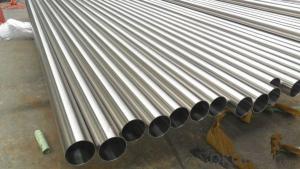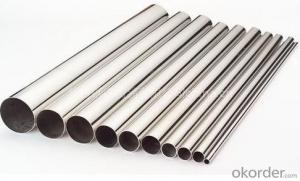Boiler Heat Exchange Stainless Steel Pipe 2205 ASTM A213
- Loading Port:
- Ningbo
- Payment Terms:
- TT or LC
- Min Order Qty:
- 25 m.t.
- Supply Capability:
- 7000 m.t./month
OKorder Service Pledge
OKorder Financial Service
You Might Also Like
1、Structure of Boiler Heat Exchange Stainless Steel Pipe 2205 ASTM A213:
Boiler Heat Exchange Stainless Steel Pipe 2205 ASTM A213 is formed by drawing a solid billet over a piercing rod to create the hollow shell. As the manufacturing process does not include any welding, Boiler Heat Exchange Stainless Steel Pipe 2205 ASTM A213 are perceived to be stronger and more reliable. Historically Boiler Heat Exchange Stainless Steel Pipe 2205 ASTM A213 was regarded as withstanding pressure better than other types, and was often more easily available than welded pipe.
2、Main Features of Boiler Heat Exchange Stainless Steel Pipe 2205 ASTM A213:
• High manufacturing accuracy
• High strength
• Small inertia resistance
• Strong heat dissipation ability
• Good visual effect
• Reasonable price
3、Boiler Heat Exchange Stainless Steel Pipe 2205 ASTM A213 Specification:
Standard | GB, DIN, ASTM ASTM A106-2006, ASTM A53-2007 |
Grade | 10#-45#, 16Mn 10#, 20#, 45#, 16Mn |
Thickness | 8 - 33 mm |
Section Shape | Round |
Outer Diameter | 133 - 219 mm |
Place of Origin | Shandong, China (Mainland) |
Secondary Or Not | Non-secondary |
Application | Hydraulic Pipe |
Technique | Cold Drawn |
Certification | API |
Surface Treatment | factory state or painted black |
Special Pipe | API Pipe |
Alloy Or Not | Non-alloy |
Length | 5-12M |
Outer Diameter | 21.3-610mm |
Grade | 20#, 45#, Q345, API J55, API K55, API L80, API N80, API P110, A53B |
Standard | ASME, ASTM |
1) Material:20#(ASTM A 106/A53 GRB.API5LGRB,GB),45#,16Mn,10#.
2) Specification range:OD:21.3-610mm,WT:6-70mm,length:6-12m or according to the requirement of clients.
3) Excutive standards:GB,ASME API5L.ASTM A 106/A53,Despite of the above standards,we can also supply seamless steel pipe with standard of DIN,JIS,and so on,and also develop new products according to the requirements of our clients!
4) Surface:black lacquered,varnish coating or galvanized.
5) Ends:Beveled or square cut,plastic capped,painted.
6) Packing:bundles wrapped with strong steel strip,seaworthy packing.
4、Packaging & Delivery
Packaging Details: | seaworthy package,bundles wrapped with strong steel strip |
Delivery Detail: | 15-30days after received 30%TT |
5、FAQ of Boiler Heat Exchange Stainless Steel Pipe 2205 ASTM A213:
①How is the quality of your products?
Our products are manufactured strictly according to national and internaional standard, and we take a test
on every pipe before delivered out. If you want see our quality certifications and all kinds of testing report, please just ask us for it.
Guaranteed: If products’ quality don’t accord to discription as we give or the promise before you place order, we promise 100% refund.
②How about price?
Yes, we are factory and be able to give you lowest price below market one, and we have a policy that “ for saving time and absolutely honest business attitude, we quote as lowest as possible for any customer, and discount can be given according to quantity”,if you like bargain and factory price is not low enough as you think, just don’t waste your time.Please trust the quotation we would give you, it is professional one.
③Why should you chose us?
Chose happens because of quality, then price, We can give you both.Additionally, we can also offer professional products inquiry, products knowledge train(for agents), smooth goods delivery, exellent customer solution proposals.Our service formula: good quality+good price+good service=customer’s trust
SGS test is available, customer inspection before shipping is welcome, third party inspection is no problem.
6、Seamless Pipe ASTM A106/53 Images:


- Q:Can stainless steel pipes be used for mining and mineral processing applications?
- Yes, stainless steel pipes can be used for mining and mineral processing applications. Stainless steel is known for its excellent corrosion resistance and durability, making it suitable for handling various corrosive and abrasive materials found in mining and mineral processing operations. Additionally, stainless steel pipes can withstand high temperatures and pressures, making them a reliable choice for transporting fluids and slurries in these applications.
- Q:Are stainless steel pipes suitable for pharmaceutical applications?
- Yes, stainless steel pipes are highly suitable for pharmaceutical applications. Stainless steel is a corrosion-resistant material that meets the strict hygiene and cleanliness requirements of the pharmaceutical industry. It is non-reactive, easy to clean, and has excellent resistance to chemicals, making it ideal for transporting pharmaceutical products safely and maintaining their integrity. Additionally, stainless steel pipes can withstand high temperatures and pressures, ensuring the efficiency and reliability of pharmaceutical processes.
- Q:Are stainless steel pipes suitable for drinking water applications?
- Stainless steel pipes are indeed appropriate for drinking water purposes. Thanks to their exceptional durability and resistance to corrosion, stainless steel proves to be an outstanding selection for the transportation of drinking water. It refrains from releasing any hazardous elements into the water and resists rust and scaling, thereby guaranteeing the cleanliness and safety of the water for consumption. Moreover, stainless steel pipes are effortlessly cleaned and maintained, thus enhancing the hygiene of the water supply. Furthermore, the prolonged lifespan and dependability of stainless steel pipes render them a cost-efficient resolution for drinking water applications.
- Q:What is the difference between seamless and seamless stainless steel pipes?
- The difference between seamless and seamless stainless steel pipes lies in the manufacturing process and the composition of the material used. Seamless pipes are manufactured by extruding a solid billet through a piercing rod to create a hollow tube. This process eliminates the need for any welds or joints, resulting in a continuous and smooth pipe with no weak points. Seamless pipes are known for their strength, durability, and ability to withstand high-pressure and high-temperature applications. They are commonly used in industries such as oil and gas, petrochemical, and power generation. On the other hand, seamless stainless steel pipes are a specific type of seamless pipe that is made from stainless steel. Stainless steel is an alloy that contains a high percentage of chromium, which provides excellent corrosion resistance and high-temperature strength. This makes seamless stainless steel pipes suitable for applications where resistance to corrosion, oxidation, and heat is crucial, such as in the food and beverage, pharmaceutical, and chemical industries. In summary, while both seamless and seamless stainless steel pipes are manufactured through a seamless process, the difference lies in the material used. Seamless stainless steel pipes offer the added benefits of corrosion resistance and high-temperature strength due to their stainless steel composition.
- Q:Why can't stainless steel tubes be cut with acetylene?
- To know why stainless steel tubes cannot be cut by acetylene, we must first understand why carbon steel can be cut by oxygen acetylene flame
- Q:Stainless steel pipe is mainly used in what areas?
- Stainless steel pipe is a kind of hollow long strip round steel, mainly used in petroleum, chemical, medical, food, light industry, machinery, instrument and other industrial pipeline and mechanical structure parts. In addition, the bending and torsional strength of the same weight is lighter, so it is also widely used in the manufacture of mechanical parts and engineering structures. It is also used to produce all kinds of conventional weapons, guns, shells and so on.
- Q:What are the common sizes of stainless steel pipes used in construction?
- The specific application and requirements determine the varying common sizes of stainless steel pipes used in construction. However, numerous construction projects commonly utilize a few standard sizes. These sizes encompass 1/2 inch, 3/4 inch, 1 inch, 1.5 inches, 2 inches, 3 inches, 4 inches, 6 inches, and 8 inches. Distinct purposes are associated with these sizes. For plumbing and water supply systems in residential and commercial buildings, smaller sizes like 1/2 inch, 3/4 inch, and 1 inch are frequently employed. They are also applicable for gas lines and ventilation systems. Larger sizes like 1.5 inches, 2 inches, 3 inches, and 4 inches are predominantly utilized in industrial contexts, including oil and gas pipelines, chemical processing plants, and power generation facilities. These pipes are engineered to accommodate higher flow rates and pressure demands. Moreover, even larger sizes like 6 inches and 8 inches find utility in specialized applications, such as large-scale industrial projects and infrastructure development. Water treatment plants, wastewater treatment facilities, and large-scale irrigation systems often employ these sizes. It is vital to acknowledge that these common sizes represent only a portion of the available options, as numerous other sizes are contingent upon the specific requirements of a construction project. Consultation with a professional engineer or contractor is always advisable to determine the appropriate size of stainless steel pipes for a particular construction endeavor.
- Q:What is the difference between stainless steel pipes and PVC pipes?
- Stainless steel pipes are made from a durable and corrosion-resistant material, while PVC pipes are made from a lightweight and cost-effective plastic. Stainless steel pipes are suitable for high-pressure and high-temperature applications, while PVC pipes are commonly used for water supply and drainage systems. Additionally, stainless steel pipes have a longer lifespan and can withstand harsh environmental conditions, whereas PVC pipes may degrade over time and are more prone to cracking or breaking.
- Q:How do stainless steel pipes compare to plastic pipes?
- Stainless steel pipes are generally considered superior to plastic pipes in terms of durability, strength, and resistance to corrosion. They have a longer lifespan, can withstand high temperatures and pressures, and are more suitable for industrial and heavy-duty applications. Additionally, stainless steel pipes are environmentally friendly as they are recyclable and do not release harmful toxins. However, plastic pipes are often more cost-effective, easier to install, and can be used in various household applications.
- Q:Stainless steel works. What saw can be sawed off?
- Hand hacksaw can, but a bit slow. It's faster with a toothed saw and a grinder.
1. Manufacturer Overview |
|
|---|---|
| Location | |
| Year Established | |
| Annual Output Value | |
| Main Markets | |
| Company Certifications | |
2. Manufacturer Certificates |
|
|---|---|
| a) Certification Name | |
| Range | |
| Reference | |
| Validity Period | |
3. Manufacturer Capability |
|
|---|---|
| a)Trade Capacity | |
| Nearest Port | |
| Export Percentage | |
| No.of Employees in Trade Department | |
| Language Spoken: | |
| b)Factory Information | |
| Factory Size: | |
| No. of Production Lines | |
| Contract Manufacturing | |
| Product Price Range | |
Send your message to us
Boiler Heat Exchange Stainless Steel Pipe 2205 ASTM A213
- Loading Port:
- Ningbo
- Payment Terms:
- TT or LC
- Min Order Qty:
- 25 m.t.
- Supply Capability:
- 7000 m.t./month
OKorder Service Pledge
OKorder Financial Service
Similar products
New products
Hot products
Hot Searches
Related keywords





























